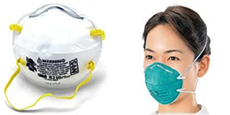Our Community Platform providing Essential Information to Know what is Real
Beaufort County Emergency Management: COVID-19 Update (4-8-20)
Face Mask Information
Protective and mitigation measures continue to evolve as we learn more about COVID-19. One of the more recent evolutions is the use of face masks by the general public. While this has been the center of many conversations, it is also a topic clouded with confusion and misinformation.
As such, we would like to provide the following clarification and guidance based on current CDC recommendations.
First, all mask are not the same, and provide different protective features when used by different people in different settings. Letís begin by looking at the more common types of mask being discussed:
Go Back
As such, we would like to provide the following clarification and guidance based on current CDC recommendations.
First, all mask are not the same, and provide different protective features when used by different people in different settings. Letís begin by looking at the more common types of mask being discussed:
- N95 Mask

- The CDC currently recommends that this style mask be used by trained medical providers when performing certain medical interventions that inherently expose the provider to respiratory droplets. Due to scarce supplies, this style mask is not recommended for daily use by members of the general public. Current quantities are needed for the protection of our health care providers.
- Surgical / Procedural Mask

- The CDC currently recommends this style mask for general use in medical settings / facilities. This mask serves as a barrier against respiratory droplets that are produced by coughing and during general conversation, therefore reducing the risk of a user transmitting illnesses to someone in close proximity. Again, due to the limited availability of this style mask, it is not recommended for daily use by members of the general public. Current quantities are needed for the protection of our health care providers.
- Cloth Face Mask / Coverings

- The CDC currently recommends this style mask for members of the general public that would like an additional level of protection. These cloth mask can be made or purchased, and serves as a barrier against droplets emitted from the user to other members of the public. (i.e. they reduce the chances of the user spreading the virus to others.) list-style-type:none;They can be washed and reused. These are not recommended for use by health care providers performing medical interventions.
- It is important to remember that using any of the masks above does not mean that you no longer have to adhere to other recommendations such as social distancing, frequent hand washing, staying home if you are sick, etc ... A mask is an additional proctective feature, and not a substitute for other recommended pratices.
- The CDC provides the following guidance for individuals choosing to utilize Cloth Face Mask / Coverings:
- Cloth Face Coverings: Questions and Answers
- This document is intended to address frequently asked questions about cloth face coverings:
- Why do you need to wear cloth face coverings?
- In light of new data about how COVID-19 spreads, along with evidence of widespread COVID-19 illness in communities across the country, CDC recommends that people wear a cloth face covering to cover their nose and mouth in the community setting. This is to protect people around you if you are infected but do not have symptoms.
- When do you need to wear a cloth face covering?
- A cloth face covering should be worn whenever people are in a community setting, especially in situations where you may be near people. These settings include grocery stores and pharmacies. These face coverings are not a substitute for social distancing. Cloth face coverings are especially important to wear in public in areas of widespread COVID-19 illness.
- Do I still need to stay at least 6 feet away from people if wearing a cloth face covering?
- Yes. Wearing cloth face coverings is an additional public health measure people should take to reduce the spread of COVID-19. CDC still recommends that you stay at least 6 feet away from other people (social distancing), frequent hand cleaning and other everyday preventive actions. A cloth face covering is not intended to protect the wearer, but it may prevent the spread of virus from the wearer to others. This would be especially important if someone is infected but does not have symptoms. View CDCís guidance on how to protect yourself.
- What type of cloth face covering should be worn?
- Cloth face coverings can be made from household items such as tightly woven cotton, quilted fabric or cotton sheets at low cost.
- Who should not wear cloth face coverings?
- Cloth face coverings should not be placed on young children younger than 2 years of age, anyone who has trouble breathing, or is unconscious, incapacitated or otherwise unable to remove the cover without assistance.
- Why is CDC recommending cloth face coverings instead of medical grade facemasks?
- Surgical masks and N95 respirators are in short supply and should be reserved for healthcare workers or other medical first responders, as recommended by CDC guidance.
- How to put on a face mask
- Clean your hands with soap and water or hand sanitizer before touching the mask.
- Remove a mask from the box and make sure there are no obvious tears or holes in either side of the mask.
- Determine which side of the mask is the top. The side of the mask that has a stiff bendable edge is the top and is meant to mold to the shape of your nose.
- Determine which side of the mask is the front. The colored side of the mask is usually the front and should face away from you, while the white side touches your face.
- Follow the instructions below for the type of mask you are using:
- Face Mask with Ear loops: Hold the mask by the ear loops. Place a loop around each ear.
- Face Mask with Ties: Bring the mask to your nose level and place the ties over the crown of your head and secure with a bow.
- Face Mask with Bands: Hold the mask in your hand with the nosepiece or top of the mask at fingertips, allowing the headbands to hang freely below hands. Bring the mask to your nose level and pull the top strap over your head so that it rests over the crown of your head. Pull the bottom strap over your head so that it rests at the nape of your neck.
- Mold or pinch the stiff edge to the shape of your nose.
- If using a face mask with ties: Then take the bottom ties, one in each hand, and secure with a bow at the nape of your neck.
- Pull the bottom of the mask over your mouth and chin.
- How to remove a face mask
- Clean your hands with soap and water or hand sanitizer before touching the mask. Avoid touching the front of the mask. The front of the mask is contaminated. Only touch the ear loops/ties/band. Follow the instructions below for the type of mask you are using:
- Face Mask with Ear loops: Hold both of the ear loops and gently lift and remove the mask.
- Face Mask with Ties: Untie the bottom bow first then untie the top bow and pull the mask away from you as the ties are loosened.
- Face Mask with Bands: Lift the bottom strap over your head first then pull the top strap over your head.
- Throw the mask in the trash. Clean your hands with soap and water or hand sanitizer.
- Clean your hands with soap and water or hand sanitizer before touching the mask. Avoid touching the front of the mask. The front of the mask is contaminated. Only touch the ear loops/ties/band. Follow the instructions below for the type of mask you are using:
- Please Note: If you are using a reusable cloth mask, at the end of the day, take the mask off from the straps (not touching the front), place in a pillowcase to keep the ties with the mask. Wash it in the washing machine with hot water and completely dry on medium or high heat.
- Be advised: Wearing a mask does not replace other important public health control measures such as hand-washing, social distancing, covering your cough and cleaning surfaces. In fact, masks are a type of personal protective equipment, which health professionals consider the last line of defense.





















